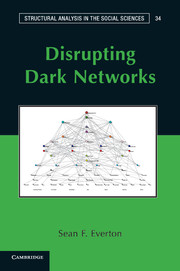Book contents
- Frontmatter
- Contents
- Figures
- Tables
- Preface
- Acknowledgments
- Part I Introduction
- Part II Social Network Analysis: Techniques
- Part III Social Network Analysis: Metrics
- Part IV Social Network Analysis: Advances
- Part V Conclusion
- Appendix 1 The Noordin Top Terrorist Network
- Appendix 2 Glossary of Terms
- Appendix 3 Multidimensional Scaling with UCINET
- Appendix 4 The Just War Tradition
- References
- Index
Appendix 1 - The Noordin Top Terrorist Network
Published online by Cambridge University Press: 05 April 2013
- Frontmatter
- Contents
- Figures
- Tables
- Preface
- Acknowledgments
- Part I Introduction
- Part II Social Network Analysis: Techniques
- Part III Social Network Analysis: Metrics
- Part IV Social Network Analysis: Advances
- Part V Conclusion
- Appendix 1 The Noordin Top Terrorist Network
- Appendix 2 Glossary of Terms
- Appendix 3 Multidimensional Scaling with UCINET
- Appendix 4 The Just War Tradition
- References
- Index
Summary
These data were drawn primarily from “Terrorism in Indonesia: Noordin's Networks,” a publication of the International Crisis Group (2006) and include relational data on the seventy-nine individuals listed in Appendix C of that publication. The data were initially coded by Naval Postgraduate School students as part of the course Tracking and Disrupting Dark Networks under the direction of Professor Sean Everton, Co-Director of the CORE Lab, and Professor Nancy Roberts. CORE Lab research assistant Daniel Cunningham reviewed and cleaned all coding made by students. Please cite as follows:
Roberts, Nancy and Sean F. Everton. 2011. Roberts and Everton Terrorist Data: Noordin Top Terrorist Network (Subset). [Machine-readable data file].
Organizational Affiliation
Definitions of Terrorist/Insurgent and Affiliated Organizations
A terrorist/insurgent organization is defined as an administrative and functional system, whose primary common goal is the operational conduct of terrorist/insurgent activities, consisting of willingly affiliated claimant members. For the purpose of this exercise, factions and offshoots will be considered separate from their parent organizations in order to prevent coding redundant ties. In other words, the most micro-level affiliations are coded, whereas an individual is coded in the parent organization only if he or she is not listed as being affiliated with a component organization. Terrorist/insurgent affiliated organizations, such MMI and FPI, are also coded in this matrix.
- Type
- Chapter
- Information
- Disrupting Dark Networks , pp. 385 - 396Publisher: Cambridge University PressPrint publication year: 2012
- 2
- Cited by



